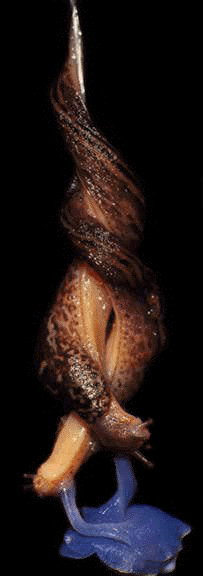|

Gastropod Main

Glossary

References

Links

Hooper Main |
Evolution 3
The pulmonates opted instead to change their structure, losing the operculum in favour of other systems of retaining moisture (such as secreting an epiphragm), and developing lungs. Another major advance was the development of penile structures which fascilitated internal fertilisation. The more primitive marine method of fertilization, by dispersal of eggs and sperm into the water, would be unfeasible on land. In addition, there has been a marked trend towards becoming hermaphroditic in the more advanced species.
 |
Figure 4: Mating Limax magnus slugs. The slugs secrete mucus in order to suspend themselves from a tree branch, and intertwine while mating. Since each is both male and female, each extends a blue penile structure and fertilises the other. Both hermaphrodicity and development of new methods of fertilization enabled these pulmonates to adapt to land. |

|

|

|

|

|

